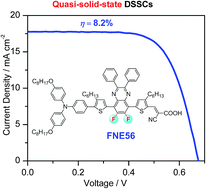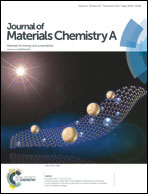Efficient quasi-solid-state dye-sensitized solar cells based on organic sensitizers containing fluorinated quinoxaline moiety†
Abstract
Two novel organic sensitizers (FNE55 and FNE56) containing a 6,7-difluoroquinoxaline moiety have been designed and synthesized for quasi-solid-state dye-sensitized solar cells (DSSCs). For comparison, an organic dye, FNE54, without fluorine has also been synthesized. The effects of the introduction of fluorine on the absorption, electrochemical and photovoltaic properties have been systematically investigated. Upon the incorporation of fluorine in the quinoxaline unit, the electron-withdrawing ability is strengthened, which results in the enhanced push–pull interactions and thus narrows the energy band gap. The absorption maximum wavelength in toluene solution bathochromically shifts from 504 nm for FNE54 to 511 nm for FNE55, and further to 525 nm for FNE56. However, although the lowest unoccupied molecular orbitals (LUMOs) are lowered down after the introduction of fluorines, the driving force for the photo-excited electrons from their excited states to the semiconductor conduction band is still sufficient. Consequently, the quasi-solid-state DSSC based on FNE56 exhibits a highest power conversion efficiency of 8.2%, which is 37% higher than that for FNE54 based quasi-solid-state DSSCs.


 Please wait while we load your content...
Please wait while we load your content...